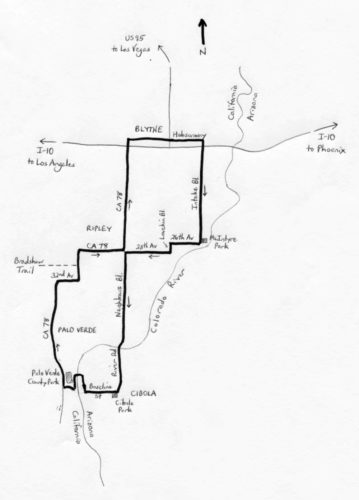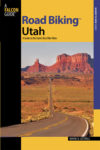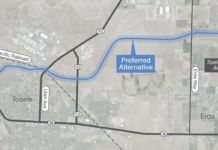
By Wayne Cottrell
Any bike ride in the Mojave Desert must be mercifully short, mainly because of the potential for extreme temperatures. This 50.65-mile ride begins and ends in Cibola, Arizona, located along the California border, in southwestern Arizona. The route consists of two clockwise loops that meet roughly at the midpoint of the ride. Cibola is located about 15 miles south of Blythe, California which, if one follows regional and national weather reports, is regularly one of the “hottest spots in the country.” In fact, Blythe’s all-time record high temperature was broken just last year, when the thermometer reached 124oF on June 20th. I was there one year earlier, when the temperature reached a much milder 111oF. As for the cycling, depending on the season, expect 90 degrees or higher from April through October. The winter months should present highs ranging from 60o to 80o. Also, expect some wind, as well as the luring, refreshing appeal of the Colorado River, which straddles this route. The ride is entirely flat, with the elevation ranging from 228 feet in Palo Verde to 268 feet in Blythe. The only “hill” is a freeway overpass!
Start the ride at Cibola Park in Cibola, adjacent the intersection of River and Baseline Roads. To get there, note that Cibola is 15 miles from Blythe, and that Blythe is 200 miles south of Las Vegas, along U.S. 95, or 150 miles west of Phoenix, along I-10. From Blythe, head south on California Highway 78 (CA 78). Just south of Ripley, head south on Neighbours Boulevard, which becomes River Road. Once across the Colorado River, enter Cibola; the park will be on the right, at Baseline Road. Cibola had a population of 170 as of 2000. At least one website lists Cibola as a ghost town, probably because of some abandoned structures. It is not a ghost town, though, and there is a resident population. Start the ride by heading west on Baseline. As you leave Cibola, the predominant land use will be agricultural. At mile 1.3, as you near the Colorado River, to the left will be the Cibola National Wildlife Refuge. The greater portion of the refuge is to the south. Because of the Colorado River waters, and several backwaters, the area is an important ecological environment within the otherwise dry desert surroundings. The refuge is on the Pacific Flyway, making it an important stopover (for birds) during their migration. At the end of Baseline, turn right onto Levee Road. Next, look for a bridge (unnamed) across the Colorado River. The bridge is a bit bumpy over the old-fashioned wooden roadbed. Note that there was a time when there were few if any bridges across the river, and one had to take a ferry boat to cross over. So, be ever thankful for the bridge. The pavement ends on the other side of the bridge. Once across, now in California (Imperial County), turn left onto the levee road on the opposite side (graded dirt). Next, take the first right onto another unnamed dirt road; you are now heading west, toward the (paved!) CA 78. The highway carries no more than 1,800 vehicles per day, so you should not expect to see more than two or three cars or trucks per minute, if that. Turn right and head north. On your right will be Palo Verde County Park, which is right along the river. There are enough trees to offers some shade. North of the park, enter the community of Palo Verde (mile 7.5). The population is nearly identical to that of its across-the-river “cousin,” Cibola, at about 170. There is a convenience store in town, in case you need refreshments.
North of Palo Verde, CA 78 enters Riverside County. The highway curves to the right, and then to the left. The intersection at 30th Street marks the endpoint, to your left, of the Bradshaw Trail, which is a scenic, backcountry byway. The trail was established in 1862 by William Bradshaw, and was used by miners and other travelers to cross the Mojave Desert, between California and gold fields in La Paz, Arizona. North of the trail, CA 78 turns to the right, and then to the left, to continue heading north. Note that, at the latter left turn, you have the option of turning right to head south – a turn here would eliminate the upper loop of the ride, making it a 26.4-mile trip. Knowing this may be useful if the temperature is exceptionally high. Continuing with the longer route, next, CA 78 enters the community of Ripley (mile 18.4), which had a population of just under 700 in 2010. The community was founded in 1920, and was intended to be a resort. A flood swept through the valley just two years later, however, thereby quashing any thoughts of that type of development. A large water tower in Ripley serves as a landmark. North of Ripley, it is a long, straight shot to I-10. After riding over the freeway, turn right onto Hobsonway (mile 24.4), which is the I-10 Business Route, and enter the city of Blythe. Hobsonway was formerly U.S. Route 70, before the construction of I-10. Blythe, with a population of 19,700 in 2016, is substantially busier than the other communities along the route. Given that the population of Blythe and the surrounding area can exceed one-half million during the winter season (when folks are looking for warmer climates), be sure to stay alert as you ride through the city. There are multiple opportunities for refreshment as your ride through Blythe.
Turn right at Intake Boulevard (mile 29.6), pass under I-10, and head south. The road leaves Blythe, and enters the agricultural lands of the Palo Verde Valley. In an interesting twist, some farmers have been paid by water authorities to NOT grow crops, as a means of conserving water. It is an interesting tradeoff strategy during periods of drought. So, you may notice a few dry areas, in between cultivated fields. McIntyre Park, another riverside park (and another opportunity to refresh), is on the left at mile 36.0. Turn right here and head west on 26th Avenue. At the end of 26th, turn left onto Lovekin Boulevard and head south, at mile 38.0. Lovekin then curves to the right, becoming 28th Avenue. At Neighbours Boulevard (mile 41.6), turn left and head south. You passed through this intersection earlier. As you near the Colorado River, Neighbours veers to the right, and then crosses over the river on a narrow bridge. The view of the river can be dramatic, particularly if there is a boat or two down there. From here, it is two and one-half miles back to Cibola, and the end of the ride.
Starting point coordinates: 33.374928oN 114.659747oW
For more rides, see Road Biking Utah (Falcon Guides), written by avid cyclist Wayne Cottrell. Road Biking Utah features descriptions of 40 road bike rides in Utah. The ride lengths range from 14 to 106 miles, and the book’s coverage is statewide: from Wendover to Vernal, and from Bear Lake to St. George to Bluff. Each ride description features information about the suggested start-finish location, length, mileposts, terrain, traffic conditions and, most importantly, sights. The text is rich in detail about each route, including history, folklore, flora, fauna and, of course, scenery.
 Wayne Cottrell is a former Utah resident who conducted extensive research while living here – and even after moving – to develop the content for the book.
Wayne Cottrell is a former Utah resident who conducted extensive research while living here – and even after moving – to develop the content for the book.








